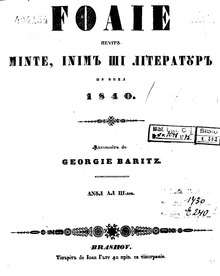Civil alphabet
The civil alphabet as well as The Romanian transitional alphabet imposes Latinization in Romanian language, Romanian literature and Romanian culture.[1]

It began to be enforced from 1828 thanks to the grammars of Ion Heliade Rădulescu,[2] although the Romanian Orthodox Church continued to use the Romanian Cyrillic for religious purposes until 1881, ie. and after the declaration of independence of Romania and the liberation of Bulgaria. The Holy Synod of the Romanian Orthodox Church decided to replace the Cyrillic alphabet in 1881 under secular pressure.[3]
The civil alphabet began to be used after 1840, first introducing Latin letters between Cyrillic letters and then replacing some Cyrillic letters with Latin letters so that the Romanian readers from Moldavia, Transylvania and Wallachia could become accustomed to them.[4] The final turning point was completed under French influence and is the result of the Wallachian Revolution of 1848 and the Crimean War with the Treaty of Paris (1856).
The complete replacement of the Cyrillic alphabet with the Latin in the United Principalities of Moldavia and Wallachia was formalized in 1862 by Prince Alexandru Ioan Cuza. The civil and already Latin alphabet became one of the symbols of Romanian unity and the national-bourgeois revolution, a direct consequence of the so-called Spring of Nations, which also affected Wallachia and Moldavia.
See also
- Bulgarian medieval cryptography
- Old Church Slavonic in Romania
- Vlach-Bulgarian royal charters
- First Romanian School
- Re-latinization of Romanian
References
- Carmen Stînea, Din colecțiile bibliotecii Muzeului Național al Unirii din Alba Iulia: primele manuale moderne românești din Transilvania
- Gramatică românească, de D. I. Eliad, Sibiu, 1828
- Virgil Malin, Înlocuirea alfabetului chirilic cu alfabetul latin în tipăriturile noastre bisericești. În: „Mitropolia Olteniei“, XIV, 1962, nr. 10 – 12, p. 624 – 640.
- Și cărțile de povești au poveștile lor.